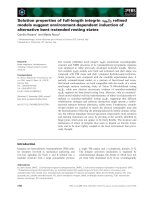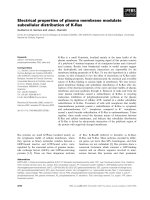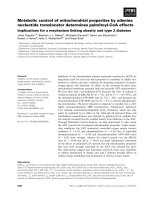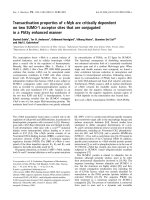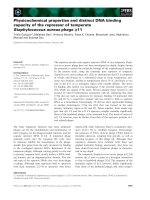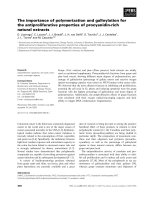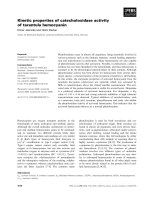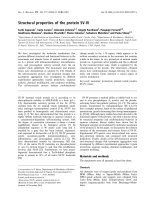Báo cáo khoa học: "Formal Properties of Metrical Structure" pptx
Bạn đang xem bản rút gọn của tài liệu. Xem và tải ngay bản đầy đủ của tài liệu tại đây (900.83 KB, 10 trang )
Formal Properties of Metrical Structure
Marc
van Oostendorp
Werkverband Grammaticamodellen
Tilburg University
P.O.Box 90153
5000 LE Tilburg
The Netherlands
oostendo~kub.nl
Abstract
This paper offers a provisional mathemat-
ical typology of metrical representations.
First, a family of algebras corresponding
to different versions of grid and bracketed
grid theory is introduced. It is subsequently
shown in what way bracketed grid theory
differs from metrical theories using trees.
Finally, we show that there are no sig-
nificant differences between the formalism
of bracketed grids (for metrical structure)
and the representation used in the work of
[Kaye, et
al.,
1985], [1990] for subsyllabic
structure.
1 Introduction
The most well-known characteristic of Non-linear
Phonology is that it shifted its attention from the
theory of rules (like in [Chomsky and Halle, 1968]) to
the theory of representations. During the last decade
phonologists have developed a theory of representa-
tions that is sufficiently rich and adequate to describe
a wide range of facts from the phonologies of various
languages.
It is a fairly recent development that these repre-
sentations are being studied also from a purely for-
mal point of view. There has been done some work
on autosegmental structure (for instance [Coleman
and Local, 1991; Bird, 1990; Bird and Klein, 1990])
and also some work on metrical trees (like [Coleman,
1990; Coleman, 1992] in unification phonology and
[Wheeler, 1981; Moortgat and Morrill, 1991] in cat-
egorial logics). As far as I know, apart from the pio-
neering work by [Halle and Vergnaud, 1987], hitherto
no attention has been paid to the formal aspects of
the most popular framework of metrical phonolog~y
nowadays, the
bracketed grids
framework.
Yet a lot of questions have to be answered with
regard to bracketed grids. First of all, some authors
(for instance [Van der Hulst, 1991]) have expressed
the intuition that bracketed grids and tree structures
(e.g. the [sw] labeled trees of [Hayes, 1981] and re-
lated work) are equivalent. In this paper, I study
this intuition in some formal detail and show that it
is wrong.
Secondly, one can wonder what the exact rela-
tion is between higher-order metrical structure (foot,
word) and subsyllabic structure. In this paper I will
show that apart from a fewempirically unimportant
details, bracketed grids are equivalent to the kind of
subsyllabic structure that is advocated by [Kaye,
et
al.,
1985], [1990] t.
2 The definition of a bracketed grid
Below I give a formal definition of the bracketed grid,
as it is introduced by HV and subsequently elabo-
rated and revised by these authors and others, most
notably [Hayes, 1991]. HV have a major part of their
book devoted to the formalism themselves, but there
are numerous problems with this formalization. I
will mention two of them.
First, their formalization is not flexible enough to
capture all instances of (bracketed) grid theory as
it is actually used in the literature of the last few
years. They merely give a sketch of the specific im-
plementation of bracketed grid theory as it is used
in the rest of their book. Modern work like [Kager,
1989] or [Hayes, 1991] cannot be described within
1In this paper, I will use
HV as
an abbreviation for
[Halle and Vergnaud, 1987] and
KLV as
an abbreviation
for [Kaye,
et al.,
19851, [1990].
322
this framework.
Secondly, their way of formalizing bracketing grids
has very much a 'derivational' flavour. They are
more interested in how grids can be built than in
what they look like. Although looking at the deriva-
tional aspects is an interesting and worthwile enter-
prise in itself, it makes their formalism less suitable
for a comparison with metrical trees.
A grid in the linguistic literature is a set of lines,
each line defining a certain subgroup of the stress
bearing elements. Thus, in 1 (HV's (85)), the as-
terisks ('stars') on line 0 represent the syllables of
the word formaldehyde, the stars on line 1 secondary
stress and line 2 represents the syllable with primary
stress:
(1) (. *) line 2
(*) (* .) (*) line 1
for mal de hyde
We can formalize the underlying notion of a line as
follows:
Definition 1 (Line) A line Liis a pair < At, -'4i>
where Ai = {a~, ,a?}, where a~, ,a n are con-
stants, n a fixed number
-~i is a total ordering on Ai such that the following
axioms hold.
a. Vot, 13, 7 ELi : ot ~i 13 A 13 ~i 7 ~" ot -41 7 (transi-
tivity)
b. Vow,
13 ELi
: a -4i
13 ::~ -'(13
"~i a) (asymmetry)
c. Va G Li : ~(a -41 a) Orreflezivity)
We say that Li C Lj if Ai C A#, a ELi if a E At.
Other set theoretic expressions are extended in a like-
wise fashion.
Yet this formalisation is not complete for bracketed
grids. It has to be supplemented by a theory about
the brackets that appear on each line, i.e. by a the-
ory of constituency and by a theory of what exactly
counts as a star on a given line.
We have exactly one dot on top of each column of
stars2.Moreover, each constituent on a line has one
star in it plus zero, one or more dots. The stars
are heads. HV say that these heads govern their
complements. This government relation can only be
a relation which is defined in terms of precedence.
Suppose we make this government relation into the
primitive notion instead of the constituent. A metri-
cal line is defined as a line plus a government relation
on that line:
Definition 2 (Metrical line) A metrical line
MLi is a pair <Li,P~>, where
Li is a line
Ri is a relation on Li and an element of {-~i,>-i, ,i
, ~-'i, '~i}
ZThat is, if we follow the current tradition rather than
HV.
With the following definitions holding3:
Definition 3 (Precedence Relations) a Ni 13 ¢~
We assume that something like Government Require-
ment 1 holds, just as it is assumed in HV that every
element is in a constituent, modulo extrametricality
(which we will ignore here).
Government Requirement 1 (to be revised be-
low) A line Limeets the government requirement iff
all dots on Li are governed, i.e. a star is in relation
Ri to them.
Now a constituent can be defined as the domain that
includes a star, plus all the dots that are governed
by this star. We have to be a little bit careful here,
because we want to make sure that there is only one
star in each constituent.
In a structure like the following we do not want
to say that the appointed dot is governed by the
first star. It is governed by the second star, which is
nearer to it:
(2)
* *
T
In order to ensure this, we adopt an idea from mod-
ern GB syntax, viz. Minimality, which informally
says that an element is only governed by another el-
ement if there is no closer governor. The definition
of Phonological Minimality could look as follows:
Definition 4 (phonological government) aGi#
(a governs 13 on line i) iff a is a star and
art13
A
-~37, 7 a star : [7R/13
A
aR/7]
We will give the formal definition of a star later on
in this chapter. The government requirement is now
to be slightly modified.
Government Requirement 2 to be revised below
A line Limeets the government requirement iff all
dots on Li are governed, i.e. a star in Liis in relation
Gi to them.
We can now formally define the notion of a
constituent 4.
aActually, HV also use a fifth kind of constituent in
their book, viz. one of the form (. * .). Because there
has been a lot of criticism in the literature against this
type of government, I will not not discuss it here.
4The reviewer of the abstract for EACL notices that
under the present definitions it is not possible to ex-
press the kind of ambiguity that is current in (parts of)
bracketed grid literature, where it is not sharply defined
whether a dot is governed by the star to its left or by
the
star to its right. This is correct. It is my present purpose
to define a version of bracketed grids that
comes closest
to trees because only in this way we can see which are
the
really essential differences between the two formalisms.
323
Definition 5 (Constituent)
A constituent on a
line Li is a set, consisting of exactly one star S in
Li plus all elements that are not stars but that are
governed by S.
We now have a satisfying definition of a metrical
line. We can define a grid as a collection of metrical
lines, plus an ordering relation on them:
Definition 6 (Grid)
A grid G is a pair < £, 1>,
where
£ = {L1 , Ln}, where LI, , L, are metrical lines
I is a total ordering on £, such that VLi, Lj • £ :
Li I L1 ¢~ [Li C Lj A Va,~3 • Li fl Lj : [a -~i Z ¢~
8]]
where C is intended to denote the
proper subset
re-
lation, so Li C L 1 ~ ",(Li = Li).
It is relatively easy to see that I by this definition is
transitive, asymmetric and irreflexive. We also define
the inverse operator T such that
Li T L 1
iff
Lj ILi.
The most interesting part of definition 6 is of
course the 1 ('above')-relation. Look at the grid in
(3) (= HV's (77), p. 262):
(3)
line 3
(. .) line 2
(. .) (.) line 1
Ten ne see
Each of the lines in this grid is shorter than the one
immediately below it, in that it has fewer elements.
This follows from elementary pretheoretical reason-
ing. Every stressed syllable is a syllable, every syl-
lable with primary stress also has secondary stress.
We expressed this in definition 6 by stating that ev-
ery line is a subset of the lines below it. By this
statement we also expressed the idea that the ele-
ments represented on the higher line are in fact the
same things as those represented on the lower lines,
not just features connected of these. The second part
of the definition says that the relative ordering of the
elements in each line is the same as that on the other
lines.
Our present definition of a metrical grid already
has some nice properties. For example, the Continu-
ous Column Constraint, which plays a crucial role as
an independent stipulation in [Hayes, 1991] can be
derived from definition 6 as a theorem:
(4)
Continuous Column Constraint (CCC): A
grid containing a column with a mark on
layer
(=our metrical line)
n+l and no mark
on layer n is ill-formed. Phonological rules
are blocked when they would create such a
configuration.
The CCC excludes grids like (5), where b is present
on the third line, but not on the second.
(5) a b
a c d
abed
We can formalize the CCC as a theorem in our sys-
tem:
Theorem 1 (CCC)VaVLiLj : (a E
Li ALi ].
e
Proof of theorem 1 Suppose a E Li, suppose
Li I Lj.
Then (by (13))
L, C Lj.
Now the stan-
dard definition of C implies VX : X ELi -"* X E Lj.
Instantiation of X by c~, our first assumption and
Modus Ponens give a E
Li.O
We can also easily define the notion of a dot and
a star, informally used in the above definitions of
government.
Definition
7 (Star and dot) 1. Va E
Li :
stari(ot)de ~f3Lj : ILl ~ Lj
A (a E Lj)]
def
e. Va ELi : doti(ot)= ~stari(ot)
Government Requirement 2 can now be fully for-
malised and subsequently extended to the grid as
a whole.
Government Requirement
3 (for lines)
fi-
nal version A metrical line Li
meets the government
requirement
iff Va ELi : doti(a) =~ 38 E Li :
^
Government Requirement 4 (for grids)
to
be revised below A grid G
meets the government re-
quirement
iff all lines in G meet the government re-
quirement.
We want to introduce an extra requirement on grids.
Nothing in our present definition excludes grids con-
sisting of infinitely many lines. However, in our lin-
guistic analyses we only consider finite construetions.
We need to express this. First, we define the notions
of a top line and a bottom line. Then we say that a
finite grid
always has one of each.
Definition 8 (Top line and bottom line)
For a
certain grid G, VLi E G
(LToP, G
=
Li)d efVLj E G : [(Li =
Lj) V (Li ~
Lj)]
(LBoTTOM,G -"
LI)~'~fVLj • G : [(ni = Lj)V(Lj 1
Li)]
Definition 9 (Finite grid)
A grid G is called a fi-
nite grid
if
3Li • G:
[Li=
LTOP, G] A 3Lj • G : [L i =
LBoTTOM,e]
Note that we have to say something special with re-
gard to the government relation in
LTOP, G.
By defi-
nition, this line has only dots in it, so it always looks
as something like (6).
(6)
There can be no star on this level. A star by defini-
tion has to be present at some higher line and there
is no higher line above LTOP, G. This means that
the LTOP, G
can
never be meeting the government
324
requirement and that in turn means that no linguis-
tic grid can ever meet the government requirement.
In order to avoid this rather unfortunate situation,
we have to slightly revise the definition of meeting
the government requirement for linguistic grids.
Government P~quirement 5 (for grids) fi-
nal version A grid G meets the government relation
iff all the
lines Li
E G -
{LTop, a} meet the govern-
ment requirement.
Definition 10 (Linguistic grid) A linguistic grid
is a finite grid which meets the government relation
A last definition may be needed here. If we look at
the grids that axe actually used in linguistic theory,
it seems that there is always one line in which there
is just one element. Furthermore, this line is the top
line (the only line that could be above it would be an
empty line, but that one doesn't seem to have any
linguistic significance).
This observation is phrased in [Hayes, 1991] as fol-
lows: if prominence relations are obligatorily defined
on all levels, then no matter how many grid levels
there are, there will be a topmost level with just one
grid mark.
We can formalize this ~s follows:
Definition 11 (Complete linguistic grids)
A linguistic grid G is called a complete linguistic
grid iff [LToP, G] = 1, i.e. 3a : [a E LTOP, G A Vfl :
L 8 e LTOP, G ::~ # O~]]
We call this type of grid complete because we can eas-
ily construct a complete linguistic grid out of every
linguistic grid.
If LTOP, G is non-empty, we construct a complete
grid by projecting the rightmost (or alternatively the
leftmost) element to a new line L/and by adding the
government requirement ~- (or -4) to LTOP, G. Fi-
nally we add the relation Lil LTOP, G to the grid,
i.e. we make Lito the new LTOP, G.
If the top line of the grid is empty, we remove
this line from the grid and proceed as above. Most
linguistic grids that are known from the literature,
are complete.
Some authors impose even more restrictions on
their grids. I believe most of those claims can be
expressed in the formal language developed in this
section. One example is [Kager, 1989], who claims
that all phonological constituents are binary. This
Binary Constituency Hypothesis can be formulated
by replacing definition 2:
Definition 12 A metrical line MLI is a pair <
Li,Ri>, where
Li is a line
Ri is a relation on Li and an element of {~i, ~i}
3 Grids and trees
In this section, we will try to see in how much brack-
eted grids and trees are really different formal sys-
terns, i.e. to what extent one can say things in one
formalism that are impossible to state in the other.
First recall the standard definition of a tree (we
cite from [Partee et al., 1990])5:
Definition 13 (Tree) A
(constituent structure) tree is a mathematical con-
figuration < N, Q, D, P, L >, where
N is a finite set, the set of nodes
Q is a finite set,
the set
of labels
D is a weak partial order in N × N, the dominance
relation
P is a strict partial order in N x N, the precedence
relation
L is a function from N into Q, the labeling function
and such that the following conditions hold:
(a)
3a E N :
V/~ G N : [<a,/~>E O] (Single root
condition)
(b) W,a ~ N : [(<~,~>~ PV <a,~>E P)
¢* (<
a,/~ >¢ D^ </~, a >¢ D)] (Exclusivity condi-
tion)
(c) Va,~,7,6 : [(< ot,/~ >E PA < a,7 >E DA <
8, 6 >E D) ~< 7, 6 >E P] (Nontangling condi-
tion)
It is clear that bracketed grids and trees have
structures which cannot be compared immediately.
Bracketed grids are pairs consisting of a set of com-
plex objects (the lines) and one total ordering rela-
tion defined on those objects (the above relation).
Trees on the other hand are sets of simple objects
(the nodes) with two relations defined on them (dom-
inance and precedence). These simply appear to be
two different algebra's where no isomorphism can be
defined.
Yet if we decompose the algebraic structure of the
lines, we see that there we have sets of simple objects
(the elements of the line) plus two relations defined
on them. One of those relations ('~i) is a strict par-
tial order, just like P. The other relation, Gi, vaguely
reminds us of dominance.
Yet a line clearly is not a tree. Although -4i has
the right properties, it is not so sure that Gi does.
While this relation clearly is asymmetric (because it
is directional), it is not a partial order.
First of all, it is not transitive. (7) is a counterex-
ample.
(7) • • +
a
b c
Here aGib and bGie but not aGie, because of min-
imality (there is a closer governor, viz. b). Gi also
5For the moment, we will not consider Q and L, be-
cause these are relatively unimportant for our present
aim and goal and there is nothing comparable to the la-
beling function in our definition of bracketed grids. This
is to say that for now we will study unlabeled trees. Notice
however that the trees actually used in the phonological
literature do use st least a binary set of labels { s, w }
325
is irreflexive, of course, because no element is to the
left or to the right of itself.
A more interesting relation emerges if we consider
the grid as a whole. Because trees are finite struc-
tures, we need to consider
linguistic grids
only. The
line LBOTTOM,G has the property that
VaVLI ~ G :
[a ~Li =~ ~
~ LBOTTOM,G]. This follows from the
definitions of LBOTTOM,G and of the 'above' rela-
tion.
This means that all basic elements of the grid are
present
on
LBOTTOM,G and, as we have seen above,
we can equal P to "~BOTTOM,G. Furthermore, we
can build up a 'supergovernment' relation {7, which
we define as the disjunction of all government rela-
tions
Gi
in G.
Definition 14 (Supergovernment)
{70 d¢__f U {<a,f~>
laG~3Adot~(~)}
LiEG
Again, we exclude the government relation of the two
stars in (7).
If we want to compare {7 to dominance, we have to
make sure it is a partial order. However, {7 obviously
still is irreflexive. It also is intransitive. Consider the
following grid for example.
(8)
•
a cd
In this grid
a{Tc
A c{Td but
,a{Td.
For this reason, we
take the transitive and reflexive closure of {7, which
we call 7"7¢{7.
LFrom this, we can define the superline of a lin-
guistic grid 6.
Definition 15 (Superline)
The
superline S/~
of a
linguistic grid G is the tuple
< ABOTTOM,G, "~BOTTOM,G, "Jf'T~{TG >.
The superline is an entity which we can for-
mally compare to a tree, with -~BOTTOM,G = P,
ABOTTOM,G = N, 7"T~{7 = D.
Of most interest are
the complete linguistic grids, firstly because these are
the ones that seem to have most applications in lin-
guistc theory and secondly because the requirement
that they be
complete
(i.e. their LTOP, G should have
exactly one element) mirrors the single root condi-
tion on trees. From now on, we will use the abbrevi-
ation CLG for 'complete linguistic grid'.
Note that we also restrict our attention to grids
which meet the government requirement, i,e. to
lin-
guistic
grids. We are not so sure that this restriction
is equally well supported by metrical theory as the
restriction to completeness. However, the restriction
6The superfine itself has no specific status in linguistic
theory. I also do not claim it should have one. The
superfine is a formal object we construct here because
it is the substructure of the bracketed grid that comes
closest to a tree.
to linguistic grids makes sure that all elements in the
grid participate in the government relation, because
everything ends as a star somewhere and hence has
to be governed by another element.
In order to somewhat simplify our proofs below, we
introduce one new notational symbol here: ~.
Definition l6 (Top Line)V~ E
AVLi ~ G :
[c~Li ¢~ c~ ~ Li A -,~Lj [a ~ Lj A L~ ~ Li]]
This symbol '_~' 'top line' denotes the highest line on
which a certain element is present. If a ~
Li,
then
Liis
the highest line at which a can be found. By
definition, this means that ~ is a dot on
Li.
Of course, for every element in a linguistic grid
there is one specific top line.
We now prove:
Theorem 2
For every linguistic grid G, ifG is com-
plete, then SLG satisfies the Single Root Condition.
Proof of theorem 2: Consider a complete linguis-
tic grid G. We have to prove that 3a E A : V~ E
A : [< a,/3 >E "/-T~{TG] (for shortness, we will refer
here and in the following to
ABOTTOM,G as A
and to
"~BOTTOM,G as "~ where no confusion arises). Con-
sider the (single) element of
LTOP.a.
We call this el-
ement 7 and prove that V/~ E A : I<7,/~>E TT~gG].
(Reductio ad absurdum.)
Suppose 3/~ E A : [<
7,/~>~ TT~{Ta]. Because this/~ is in A, 3Li : ~_ELi].
We now take the highest/3 for which this condition
is true, i.e.
V~ E A : [<7,~>~ TT~{TG =~ 3Lk :
[~E_L~ALk T
Li]]
/~_ELI by definition means that there is no Lj higher
than
Li
of which/~ is a member. But this in turn
means that/3 is a dot on Li (or doti(/~)).
Li cannot be equal to
LTOP, G,
because in that case
we
would have/3 7 and since 7"~{TGis reflexive,
< 7,/3 >E TT~{TG, contrary to our assumption. So
LTOP, G ~ Li
Because doti(/~) and the grid meets the govern-
ment requirement 36 : [stari A
6Gi7].
From the defi-
nition of supergovernment we then get that < 6,/~>E
T ~{T G
6 is a star on Li. This means that
3Lm : [6~Lm A
Lm ~ Li].
We can conclude now that < 7,6 >E
TT~{TG holds, because
delta
is on a higher line than
/3 and we assumed /3 was the highest element for
which this condition did
not
hold.
But now we have < 6, fl >E q'T~{TaA < 3', 6 >E
TT~{TG and because TT~{Tais transitive, < %/3 >E
"/'7~{7G. This is a contradiction with our initial as-
sumption. []
So superlines have one important characteristic of
trees. Yet
exclusivity
and
nontangling
still do not
hold for superlines of CLGs, even if they meet the
government requirement.
A counter example to exclusivity is (9), where a -~
bA <a,b>E TT~{TG.
326
(9) • *
a b
A counterexample to the nontangling condition is
(10), where a -~ bA <
a,c
>• 7"TCGcA <
b,c >•
q'7~Ga but c ~ c.
(10) *
~-
• * +
a
b c
The reason why these conditions do not hold is that,
on lines as well as on superlines, elements can both
govern and precede another element. Exclusivity and
nontangling are meant to keep precedence and dom-
ination apart.
Sometimes in the literature on trees (e.g. Samp-
son 1975) we find some weakening of the definition
of a tree, in which exclusivity and nontangling are
replaced by the
Single mother condition.
We first define the
mother
relation, which is im-
mediate dominance:
Definition 17 (Mother)
to be revised below
For all T, T a tree
Va/9 • T[aM/9
¢~< a,/9 >• D[= TT~G] A -~37 : [<
a,7>• D[=
7"T~6G]A
<%/9>6 D[=
7-TdgG]]]
Definition 18 (Single mother condition)
Va,/9, 7:[(aM~9 A 7M/9) ¢=> (a = 3')1
Because
7-~G
is the transitive closure of TONG, we
can rephrase defintion 17) as definition 19 for super-
lines of CLGs:
Definition
19 (Mother)
final version For all
snperlines
8 f.G
Va/9 6_ S£a[aMt~ ¢~< a,/9>6
7~#a]
We can now prove:
Theorem 3
For every grid G, if G is a CLG then
Sf.G
satisfies the Single Mother Condition.
Proof of theorem 3: (By
RAA.)
Suppose a,/9, 7 •
S£G
and aM/9 A 7M/9 A a # 7- If aM/9, then by
definition 19, < a,/9>• ~Ta, and if 7M/9, similarily
<7,/9>6 TONG. Because a # 7, we have a # /9.
For if a =/9, we would have 7Ma A
aM~9.
But by
(19) we then cannot have 7M/9. A similar line of
reasoning shows that/9 ~ 7. So a ¢ 7 A 7 ¢/9. By
(17) this means that [< a,/9>6 ~GA < 7, ~
>6 Ca],
because 7ZQG is the transitive closure of GG. We
have reached the following proposition:
Proposition 1
The mother relation equals ~ on su-
perlines: V~/9
• SfG
: [otMfl
=~< a,/~>6
~G]
Definition 14 says that if < a,/9>• fig there is a line
L/such that
aGi/gAdoti(~)}.
Also, if < %/9 >• Ga
there is a line Ljsuch that
7Gj/gAdob(#)}.
Because
can by definition be a dot at exactly one line,
Li=
Ljand
otGi/9
and
7Gi/9.
However, from the minimal-
ity definition of government (4), it follows that in
that case (~ = 7. Which is a contradiction. []
4 Dependency Trees
Let us summarize the results so far. We have seen
that from bracketed grids we can extract
sup•tithes,
on which the government relations of the normal lines
are conflated.
These superlines are equivalent to some sort of un-
labeled trees, under a very weak definition of the lat-
ter notion. Whereas the minimal restrictions of the
Single Root Condition and the Single Mother Condi-
tion do hold, the same is not necessarily true for the
Exclusivity Condition and the Non-Tangling Condi-
tion.
It can be shown that in the linguistic literature
a form of tree occurs that is exactly isomorphic to
bracketed grids. These are the trees that are used in
Dependency Phonology.
We did not yet discuss what the properties of these
trees are. This is what we will briefly do in the
present section.
First let us take a look at the kind of tree we can
construct from a given grid. We give the CLG in
(11) as an example:
(11)
LTOP, G
* b-
e?
/,From this grid we can derive a superline 8£a
with {~G =
{<a,b>,<c,d>,<e,f>,<e,a>,<
e, c >}. If we interpret this as a dominance relation
and if we draw dominance in the usual way, with the
dominating element above the dominated one, we get
the following tree:
(12) e
b d f
This tree looks rather different than the structures
used in the syntactic literature or in metricM work
like [Hayes, 1981].
Yet there is one type of structure known in the
linguistic (phonological) literature which graphically
strongly resembles (12). These are the
Defendency
Graphs
(DGs) of Dependency Phonology ([Durand,
1986] a.o.).
According to [Anderson and Durand, 1986], DGs
have the following structure. They consist of a set
of primitive objects together with two relations,
de-
pendency
and
precedence.
For example within the
syllable/set/the following relations are holding (no-
tice some of the symbols we introduced above are
used here with a slightly different interpretation):
Dependency s , e * t (i.e. /s/ depends on/e/
and/t/depends on
~el.
327
Precedence s < e < t (i.e. /s/ bears a relation
of 'immediate strict precedence to/e/which, in
turn, bears the same relation to/t/.
Anderson and Durand also introduce the transi-
tive closure of 'immediate strict precedence', 'strict
precedence', for which they use the symbol << and
the transitive closure of dependency, 'subordination',
for which they use the double-headed arrow. More-
over, well-formed dependency graphs conform to the
following informal characterisation (=Anderson and
Durand's (10)):
Definition 20 (Dependency graph)
( Anderson and Durand's (10))
1. There is a unique vertex or root
2. All other vertices are subordinate to the root
3. All other vertices terminate only one arc
4. No element can be the head of two different con-
structions
5. No tangling of arcs or association lines is al-
lowed
20.1 and 20.2 together form a redefinition of the
Single Root Condition. Theorem 2 states that su-
perlines of CLGs with the government requirement
satisfy this Condition.
Because 'arcs' are used as graphic representations
for dependency (which is intransitive), 20.3 seems a
formulation of the Single Mother Condition. Theo-
rem 3 states that this condition also holds for super-
lines of complete linguistic grids.
20.4 needs some further discussion because it is
the only requirement that does not seem to hold for
our grids. The condition says that something cannot
be a head at more than one level of representation,
e.g. something cannot be the head of a foot and of
a word. However, because of the CCC, in bracketed
grid systems the head of a word always is present (as
a star - hence as a head) on the foot level.
It is exactly this requirement that is abandoned by
all authors of at least Dependency Phonology. [An-
derson and Durand, 1986] (p.14) state that one el-
ement can be the head of different constructions, as
indeed we have already argued in presenting a given
syllabic as suecesively the head of a syllable, a foot
and a tone group.
In order to represent this, a new type of relation
is introduced in their system, subjunction. A node a
is subjoined to/3 iff (~ is dependent on/3 but there is
no precedence relation between the two.
The word intercede then gets the following repre-
sentation:
(13) o
O O
b,,
o o I
I I
in ter cede
We once again cite [Anderson and Durand, 1986]
(p.15):
The node of dependency degree 0 is ungoverned
(the group head). On the next level down, at de-
pendency degree 1, we have two nodes governed by
the DDO node representing respectively the first foot
(inter) and the second foot (cede). The first node
is adjoined to the DDO node, the second one is sub-
joined. Finally, on the bottom level, at DD2, the
nodes represent the three syllables of which this word
is comprised. These latter nodes are in turn governed
by the nodes at DD1 and once again related to them
by either adjunction or snbjunction.
Lifting the restriction this way seems to be exactly
what is needed to fit the superline into the DG for-
malism.
20.5 holds trivially in the bracketed grid frame-
work as well. It can be interpreted as: if ~ precedes
/3 on a given line in the grid, there is no other line
such that/3 precedes c~ on that line. This is included
in the definition of the '~' relation,
The difference between a phonological DG and
a bracketed grid is the same as the difference be-
tween a superline and a bracketed grid: the DG is
not formally divided into separate lines. Interest-
ingly, [Ewen, 1986] analyses English stress shift, one
of the main empirical motivations behind the grid
formalism, with subjunction. In [Van Oostendorp,
1992b] I argue that using subjunction Ewen's way
actually means an introduction of lines into Depen-
dency Phonology.
5 Government Phonology
Now let us turn over to a well-known phonological
theory that also employs the notion of government
as well as 'autosegmental representations'. I refer of
course to the syllable theory of KLV and [Charette,
1991].
This theory of the syllable in fact does not have
a syllable constituent at all. In stead of such a con-
stituent, KLV postulate a line of x-slots and par-
alelly, a tier of representation which conforms to the
pattern (0 R)* - that is an arbitrary number of rep-
etitions of the pattern OR.(KLV [1990]) The term
'tier' suggests an autosegmental rather than a met-
rical (bracketed grid) approach to syllable structure,
but KLV are never explicit on this point.
The fact that O and R appear in a strictly regular
pattern can be explained either by invoking the (met-
rical) Perfect Grid requirement or, alternatively, the
328
(autosegmental) OCP. The same applies to the 'la-
bels' O and R: we can define them autosegmentally
as the two values of a type 'syllabic constituent' or in-
directly as notational conventions for stars and dots
on a 'syllable line', i.e. we could have the following
representations for KLV's (O R)* line:
(14) a. tier:.
[type: syll.const; vMue: O; ] [type:
syll. coast;
v~lue:
R; ],
etc.
b. line:
*, etc.
For (14b), we would have to show that the rhymes
or nuclei project to some higher line. We will return
to this below.
We still cannot really decide between an autoseg-
mental and a metrical approach. If we look at more
than one single line, this situation changes.
At first sight, it then seems very clear that KLV's
syllables act as ARs, not as grids. For instance, we
can have representations like (15) (from [Charette,
1991]), with a floating Onset constituent:
(15) Ort O R
I I I
X X X
I I I
a m 1
This is a possible autosegmental chart, but not
a possible grid (because the Complex Column Con-
straint is violated by the word initial onset). How-
ever, empirical motivation for (15) is hard to find. As
far as I know, the structure of (15) is motivated only
by the assumption that on the syllabic line we should
find (OR)* sequences rather than, say, (R)(OR)*.
The same state of poor motivation does not hold,
however, to the representation [Charette, 1991] as-
signs to words with an 'h aspir6'7:
(16) O R
I I
X X X
I I
a §
As is well known, the two types of words behave
very differently, for example with regard to the def-
inite article. While words with a lexical represen-
tation as in (16) behave like words starting with a
'real', overt, onset, words with a representation like
(15) behave markedly different:
(17) a. le tapis- *l' tapis
b. la hache - *l' hache
c. *la amie - l' amie
It seems that, while the empty onset of (15) is
invisible for all phonological processes, the same is
not true for the empty onset of (16).
rI disregard the (irrelevant) syllabic status of the final
[§] consonant.
So there are two different 'empty onsets' in KLV's
theory s. Notice that the type of empty onset for
which there is some empirical evidence is exactly the
one where the (0 R) - x slot chart does behave like
a grid (i.e. where it does not violate the CCC).
So whereas we have here a formal difference be-
tween KLV's theory and grid theory, this has no real
empirical repercussions.
Another similarity is of course the notion 'govern-
ment'. For KLV, government only plays a role on
the line of x-slots. [Charette, 1991J(p. 27) gives the
following summary:
Governing relations must have the following prop-
erties:
(i) Constituent government: the head is initial and
government is strictly local.
(it) Interconstituent government: the head is final
and government is strictly local.
Government is subject to the following properties:
(i) Only the head of a constituent may govern.
(il) Only the nuclear head may govern a constituent
head.
The most important government relation is con-
stituent government: this is the relation that defines
the phonological constituent. Moreover, the 'prin-
ciples' given by Charette are only introduced into
the theory to constrain interconstituent government.
By definition, constituent government remains unaf-
fected by these. (As for (i), the definition of the no-
tion constituent implies that it is only the head that
governs and (it) does not apply because we never find
two constituent heads within one constituent).
The two conditions on constituent government
(that the head be initial and the governee adjacent
to it) can be expressed in our formalisation of the
grid in a very simple way:
Definition 21 Rx-stot =~'-"
According to KLV, * is the only possible con-
stituent government relation. Other candidates like
{ ~, ~-,-~,,~} are explicitly rejected, so in fact we
have (with some redundancy):
Definition 22 VLi : [R/E {~-)] A R~-,lot =*'
8[Piggot and Singh, 1985] propose a different distinc-
tion, namely one in which the empty onset of ami is rep-
resented as (in) and the one of hache as (ib) (0 is a null
segment):
(i) a. 0 b. 0
I I
X X
I
0
Under this interpretation of Government Phonology,
the syllable structure is formally even more similar
to
grids, if we assume that the linking between segmental
material and x-slots has to be outside the grid (treated
as autosegmental association) anyway.
329
This is one of the reasons why KLV do not accept
the syllable as a constituent: under their definition
of government, this would make the onset into the
head of the syllabic constituent.
At least we can see from these definitions that the
x-slot line in KLV's theory behaves like a normal
metrical line.
Yet there is one extra condition defined on this
line; this is called interconstituent government. Be-
cause of the restrictions in (15), KLV notice that this
type of government only concerns the following con-
texts. (Square brackets denote domains for intercon-
stituent government, normal brackets for constituent
government):
(18) a. N O
A I
(x Ix) (x]
b. NON
I I
[(x) (xl
c. 0 R
I I
Ix) (x]
But the fact that there is an extra condition on a
line does not alter its being metrical, even if we call
this extra condition a government relation 9.
We now have reached the following representation
(20) of the grid variant of the x line in (19) (we use
the star-and-dot notation and leave out the associa-
tion of the autosegmental material to the skeleton):
(19) O R O R
I IAi
X X X X X
I I I I I
p a t r l
(20) O R O tt
(*) (*) (* .) (*)
By definition, stars are present on a higher line.
As we have seen above, there is no reason not to
consider the (O R)* tier to be this higher line. We
then get the following representation:
(21) (. *) (. *) line 2 (?)
(*) (*) (* .) (*) line l(~)
p a t r i
As we noted above, KLV do not accept any con-
stituents on the higher line. One of their reasons was
their stipulation that all constituents are left-headed.
There are independent reasons to abandon this re-
striction. [Charette, 1991] argues for a prosodic anal-
ysis of French schwa/[e] alternations. In order to do
this, she has to build metrical (Is w] labeled) trees
representing feet on top of the nuclei. She gives the
9In
[Van Oostendorp, 1992a] I sketch a way of trans-
lating 'interconstituent government' to a bracketed grid
theory of the syllable.
following crucial example [Charette, 1991] (p.180, ex-
ample (llc)):
(22) F
W S
I I
N N
I I
0 N O N
I I I I
X X X X
I I I I
m ~ n e
Here we have a clear case of a right-headed phono-
logical constituent, namely the foot.
Furthermore, we see that the nuclei are projected
from the (O R)* line to aiine where they are the
single elements. If we change the top N's in this
picture into ~'s we have something like a metrical
syllable line.
If we incorporate these two innovations into our
theory, we can translate th structure in 22 into a
perfectly normal grid, in fact into a complete linguis-
tic grid:
(23)
- head-of-foot (
LTOP, G)
(. *) Soot (-)
(. *) (. *) syllab, const. (~)
(*) (*) (.) (*) x-nine( )
I I I I
m O n e
Concludingly, we can say that, although KLV's
syllable representations are somewhat different from
linguistic grids, two minor adjustments can make
them isomorphic:
• in stead of (O R)* we assume (R)(O R)*, i.e.
there can be onsetless syllables (KLV themselves
note that most of the (O R)* stipulation can
be made to follow from independent stipulations
like interconstituent government). This follows
a forteriori for the (R)(O R)* stipulation.
• in stead of 22 we assume VR~ : [R~ E {~ ,
}] ^ R~_,~. =*
The
first conjunct of this definition is simply
my translation of Kager's ([1989]) Binary Con-
stituency Hypothesis 12 and the second con-
junct does the same as the original definition of
KLV: it gives the correct choice of government
for the subsyllabic line.
As far as I can see, none of these modifications
alters the empirical scope of KLV's theory in any
important way. I conclude that for all practical pur-
poses, KLV's representation of the syllable equals my
definition of a linguistic grid.
6 Conclusion
In this paper we have seen that three more or less
popular representational systems in modern phonol-
ogy are notational variants of each other in most
330
important ways: these are bracketed grid theory,
Dependency Phonology and Government Phonology.
The basic ideas underlying each of these frameworks
are government/dependency on the one hand and the
division of a structure into lines on the other.
The similarity between the frameworks is obscured
mainly by the immense differences in notation; but
we have shown that the algebraic systems underlying
these formalisms is basically the same.
In [Maxwell, 1992] it is shown that the differences
between Dependency Graphs and X-bar structures as
used in generative syntax are minimal. It remains to
be shown whether there are any major formal differ-
ences between the bracketed grids that are presented
in this paper and the 'X-bar-structures-cure-lines' as
they are represented in [Levin, 1985] and [Hermans,
1990].
Acknowledgements
I thank Chris Sijtsma, Craig Thiersch and Ben Her-
marls and the anonymous EACL reviewer of the ab-
stract for comments and discussion. I alone am re-
sponsible for all errors.
References
[Anderson and Durand, 1986] John Anderson and
Jacques Durand 'Dependency Phonology' In: Du-
rand (1986)
[Bird, 1990] Steven Bird Constraint-Based Phonol-
ogy Doctoral dissertation, Edinburgh.
[Bird and Klein, 1990] Steven Bird and E. Klein
'Phonological events' Journal of linguistics 29.
[Charette, 1991] Monik Charette Conditions on
phonological government Cambridge, Cambridge
University Press, 1991.
[Chomsky and Halle, 1968] Noam
Chomsky and Morris Halle The Sound Pattern
of English. MIT Press, Cambridge (Mass.) 1968.
[Coleman, 1990] John Coleman 'Unification phonol-
ogy: Another look at sythesis-by-rule.' In: H.
Karlgren (ed.) Proceedings of COLING lggo. In-
ternational Committee on Computational linguis-
tics, Vol. 3:79-84.
[Coleman, 1992] John Coleman 'The phonetic inter-
pretation of headed phonological structures con-
taining overlapping constituents' Phonology 9.1.
[Coleman and Local, 1991] John Coleman and John
Local The 'No Crossing Constraint in Autoseg-
mental Phonology' Linguistics and Philosophy
295-338.
[Durand, 1986] Jacques Durand (ed.) Dependency
and non-linear phonology Croom Helm, London,
1986.
[Ewen, 1986] Colin Ewen 'Segmental and superseg-
mental structure' In: Durand (1986)
[Halle and Vergnaud, 1987] Morris Halle and Jean-
Roger Vergnaud An essay on stress MIT Press,
Cambridge (Mass.) 1987.
[Hayes, 1981] Bruce Hayes A metrical theory of
stress rules Doctoral dissertation, MIT.
[Hayes, 1991] Bruce Hayes Metrical stress
theory:
Principles and case studies. Manuscript, UCLA.
[Hermans, 1990] Ben Hermans 'On the fate of stray
syllables' In: J. Masearo and M. Nespor (eds.)
Grammar in progress: GLOW essays for Henk van
Riemsdijk. Dordrecht, Foris, 1990.
[Van der Hulst, 1991] Harry van der Hulst 'The
book of stress' Manuscript, Leiden University,
1991.
[Kager, 1989] Ren~ Kager A metrical theory of stress
and destressing in English and Dutch Doctoral
dissertation, Rijksuniversiteit Utrecht, 1989.
[Kaye, et al., 1985] Jonathan Kaye, Jean Lowen-
stamm and Jean-Roger Vergnaud 'The internal
structure of phonological elements: a theory of
charm and government' Phonology yearbook 2:305-
328.
[Kaye, et al., 1990] Jonathan Kaye, Jean Lowen-
stamm and Jean-Roger Vergnaud 'Constituent
structure and government in phonology' Phonol-
ogy 7.2
[Levin, 1985] Juliette Levin A metrical theory of syl-
labicity Doctoral dissertation, MIT. Cambridge
(Mass.), 1985.
[Maxwell, 1992] Dan Maxwell 'Equivalences be-
tween constituency and dependency.' In: J. van
Eijck and W. Meyer Viol (eds.): Computational
linguistics in the Netherlands; Papers from the
second CLIN-Meeting 1991. Utrecht, OTS, 1992.
[Moortgat and Morrill, 1991] Michael Moortgat and
Glynn Morrill 'Heads and Phrases; Type calculus
for dependency and constituent structure' To ap-
pear in Journal of logic, language and information
[Van Oostendorp, 1992a] Marc van Oos-
tendorp 'The grid of the French syllable' In R.
van Hout and R. Bok-Bennema (eds.) Linguistics
in the Netherlands Igge. Amsterdam, Benjamins.
[Van Oostendorp, 1992b] Marc van Oosten-
dorp 'The isomorphism between bracketed grid
and dependency phonology' Manuscript, Tilburg
University.
[Piggot and Singh, 1985] Glynn Piggot and Rajen-
dra Singh 'The phonology of epenthetie segments'
Revue Canadienne de Linguisiiqne 30.4:415-453.
[Partee et al., 1990] Barbara Partee, Alice ter
Meulen and Robert Wall Mathematical methods
in linguistics Dordrecht: Kluwer Academic.
[Wheeler, 1981] Deirdre Wheeler Aspects of a cat-
egorial theory of phonology Doctoral dissertation
Amherst, 1981.
331
